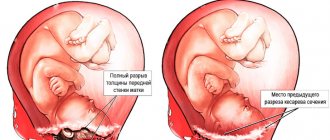Currently, more and more women are appearing with a uterine scar.
This happens for a number of reasons: expansion of indications for cesarean section, increase in reconstructive operations (conservative myomectomy).
For this reason, the question of further delivery of such women becomes acute. Many obstetricians adhere to the rule “one cesarean, always a cesarean.” But how valid is this judgment and are there exceptions to this rule?
Why does a scar form on the uterus?
A woman most often learns about what a uterine scar is after a cesarean section. As a result of this operation, the mucous membrane and nerve endings of the uterovaginal plexus are damaged, and upon completion, a postoperative suture is placed on the uterus, which after six months to a year is transformed into a dense formation - a scar.
The condition of the postoperative suture is carefully monitored by a gynecologist, assessing its appearance and structure. And only a few months or even a year after the formation of the scar, the doctor gives a final conclusion: whether the woman will be able to give birth to subsequent children on her own.
What other reasons, besides cesarean section, can lead to a uterine scar?
- damage (rupture) of the uterus during hyperstimulation of labor;
- rapid labor;
- multiple pregnancy;
- ruptures of the cervix, perineum, and uterine walls.
Is it possible to give birth after a cesarean section on your own?
Most women do not stop at one child, but give birth to several children. And after a cesarean section, many wonder whether it is possible to give birth later, and in general to become pregnant and bear a child. It's possible. Moreover, you can give birth a second time, not only with the help of the same Caesarean, but by yourself. To do this, it is necessary that a sufficient amount of time has passed, the postoperative suture has tightened and become stable, and the woman must fully recover after a cesarean section. It is very important. Only a doctor can decide whether the woman herself will give birth or again by cesarean section, who will monitor her throughout the pregnancy and also monitor the condition of the suture.
If you don’t rush, wait the required amount of time to make sure that the suture is strong, you can get pregnant, carry it to term, and give birth to a healthy baby without complications. The main thing is to take your time, make sure that everything is in order, be sure to plan your pregnancy with your doctor, so that he definitely allows it after checking everything.
Monitoring the condition of the uterine scar
After a woman is discharged from the maternity hospital with a uterine scar, the gynecologist will monitor the condition of her scar for a whole year.
To do this, the doctor may prescribe:
- Ultrasound: to assess the shape, length and thickness of the scar, the possible presence of cracks or tears in it;
- X-ray (hysterography): to more accurately assess the structure of the scar;
- hysteroscopy: the uterine cavity is examined with a hysteroscope to see the color of the scar and evaluate the blood network in its tissues;
- MRI: to understand how strong the muscle tissue of the scar is.
How is the recovery going?
The recovery period after a repeat cesarean section also has its own characteristics. A woman’s recovery takes longer than after the first operation, and this is quite natural, because the muscles of the uterus are more stretched, and repeated opening of this muscular organ complicates the postpartum involution of the uterus. After the operation, the uterus remains quite large, but looks more like a deflated balloon or an empty sac. She needs to shrink back to her previous size. This process in involution is considered the most important.
To help the postpartum woman, doctors begin to administer contracting drugs to her from the first hours after transfer from the operating room to the intensive care ward. After a few hours, the woman is transferred to the general postpartum ward, where she is advised not to stay for a long time. It is optimal to get up 10–12 hours after surgery. Physical activity will promote uterine involution. For the same purpose (and not only this!) it is recommended to put the baby to the breast as early as possible. The baby will receive nourishing and healthy colostrum, and the production of its own oxytocin in the mother’s body will increase, which will definitely have a positive effect on the contractility of the uterus.
Scar on the uterus: norm and pathology
A healthy uterine scar is a scar with a good level of elasticity. It mainly consists of muscle cells and is close in composition to the tissues from which the uterine wall is built. If your scar is considered healthy, it means it will withstand the next pregnancy and childbirth. To make a final conclusion, the doctor will determine the thickness of the suture: the norm for a scar on the uterus during pregnancy planning should be at least 3 millimeters. This margin of safety is considered good, considering that the seam will stretch and reach 1-2 millimeters by the third trimester. With such parameters, the risk of suture divergence will be unlikely and, most likely, the woman will be able to give birth on her own.
Is a scar on the uterus so dangerous?
Expert comment:
A modern doctor considers a woman’s condition not from the point of view of the thickness of the scar on the uterus, he evaluates the clinical manifestations of her pregnancy. If a pregnant woman does not have local pain when palpating the scar (she can touch it on her own), there is no bleeding from the genital tract, and the child feels well according to CTG, the thickness of the uterine scar is not of fundamental importance. In accordance with European clinical guidelines, the thickness of the uterine scar is considered normal to be about 2 mm, in accordance with Russian recommendations - about 3 mm. These scar parameters allow a pregnant woman to safely carry and give birth to a child. By the way, today all maternity hospitals in Moscow are ready to accept spontaneous births from pregnant women with a uterine scar, but in reality this still happens only in 1% of cases. In most cases, doctors are not yet ready for such deliveries and prefer to perform a cesarean section on a pregnant woman with a scar.
An incompetent scar on the uterus has a very small thickness - no more than 1 millimeter. Usually such a thin seam is not uniform: along its length there are very thin threads, thickened fragments, and indentations. It contains practically no elastic muscle fibers, but consists of connective tissue that does not stretch well. The thinning of the uterine scar during pregnancy is the reason why the gynecologist informs the woman that there is a problem: as the fetus grows and the uterus enlarges, there is a high risk of uterine scar rupture during pregnancy.
How dangerous is uterine suture dehiscence?
Expert comment:
In case of divergence, the scar does not burst like a soap bubble, it spreads along the seams, and this process occurs within 4-5 hours. In this case, the pregnant woman experiences aching pain and bleeding. You shouldn’t be afraid of this, because in such a situation the woman has enough time to come to the maternity hospital without panic.
Childbirth with a scar on the uterus can be considered safe, provided that the pregnant woman:
- the placenta is outside the scar;
- fruit weight does not exceed 3600 g;
- having only one cesarean section;
- body mass index does not exceed the norm;
- when suturing, modern absorbable suture material was used;
- there is no anatomical narrowing of the pelvis;
- The thickness of the lower segment of the suture according to ultrasound is at least 3 mm.
When is natural childbirth after surgery contraindicated?
A high risk of complications is possible if:
- The presence of two or more operations in the anamnesis.
- Corporate access during the previous operation.
- Complicated postoperative period (fever, purulent diseases, endometritis, metroendometritis, suture dehiscence).
- Laparoscopic removal of a myomatous node in history with coagulation of the bed (with the exception of pedunculated subserous nodes).
- Surgical abortions after surgery.
- After the previous operation, less than a year passed before the onset of this pregnancy.
- Narrowing of the pelvis.
- Incorrect placement of the fetus.
- According to ultrasound: signs of scar tissue failure (thinning, niches).
- Pain on palpation of the uterus.
- Placentation in the projection of scar tissue.
- Pathology of labor.
Pregnancy with a scar on the uterus
Women who have had a cesarean section often wonder: how to combine a uterine scar and pregnancy? According to experts, this is quite possible, but certain rules must be followed.
- First, try to avoid another pregnancy and abortion for 2 years after a cesarean section. In two years, an elastic, wealthy scar on the uterus can form. It will not be possible to place an intrauterine device to prevent pregnancy in such a situation, so the woman will need to choose either a barrier method of contraception or a hormonal one.
- Secondly, the maximum break that gynecologists recommend taking before planning another pregnancy is no more than 4 years. Later, the muscle fibers of the suture will gradually atrophy and lose the ability to stretch elastically.
Childbirth with a scar on the uterus
If the doctor assesses the uterine scar as incompetent, the woman will most likely have a planned cesarean section. In the case of a strong suture, it is quite realistic to expect a natural birth with a uterine scar. However, such a woman in labor is usually sent not to a standard maternity hospital with a regular delivery room, but to a multifunctional center where emergency (within 10 minutes) assistance from a surgeon, anesthesiologist and neonatologist is possible. A woman will need the help of these specialists if a uterine rupture occurs during natural childbirth. In addition, the entire birth process takes place while monitoring the fetal cardiac activity.
When the birth has already taken place, the gynecologist will inject the woman with intravenous anesthesia and then examine and palpate the walls of the uterus to understand whether there are ruptures or cracks in the scar area. If problems are detected, an urgent operation will be immediately scheduled: to prevent intra-abdominal bleeding, the resulting rupture will be sutured.
Second caesarean section: what is important to know
As I said above, any operation is individual, and childbirth cannot take place in the same way. But these differences should not cause anxiety and panic in the woman in labor. The main thing is to familiarize yourself with them and set yourself up correctly before the operation.
So, second cesarean section: what is important to know:
- How many weeks? Most often - at 37-39, but if there are indications for this, the doctor may insist on an earlier delivery.
- When are they sent to the hospital? If the pregnant woman and the fetus are absolutely healthy - a couple of days before the appointed date. But it’s better - in a week or two.
- What anesthesia is used? Both local and general, but the dose is stronger than for the first CS, since repeated births last longer.
- How is it cut? According to the old scar, so a new scar will not appear.
- How long does the process take? A little longer than the first birth, approximately 1–1.5 hours.
It is also worth considering that the recovery process in this case will be longer and more complex. This is due to the fact that skin that is excised repeatedly takes longer to heal. The involution of the uterus also occurs more slowly, causing discomfort. But if you follow all the rules of the rehabilitation period, it will pass as soon as possible.
How to speed up scar healing?
Expert comment:
This can be done with the help of stem cells: research shows that the introduction of mesenchymal stem cells safely speeds up scar healing. At the same time, the cells themselves are completely eliminated from the woman’s body after 2-3 months.
Expert comment:
For expectant mothers who have already had one elective cesarean section, the chances of giving birth spontaneously with a uterine scar are close to 100%. At our National Medical Research Center for Obstetrics, Gynecology and Perinatology. IN AND. Kulakov, pregnant women with a scar on the uterus are not hospitalized in advance - we always wait for the woman to develop independent labor. We say to such a pregnant woman: “Come to us exactly at 40 weeks.” Thus, we give the woman a chance to have contractions without stimulation, without opening the amniotic sac. If at 40 weeks of pregnancy contractions still have not begun and water has not broken out, we perform a repeat cesarean section.
- Expert
- Latest articles
- Feedback
Time of surgery
The average period of preliminary labor is calculated by the doctor. The preliminary date of natural birth is set at the end of the 38th week of pregnancy. The normal period can vary from 38 to 40 weeks. In case of caesarean section, the PDR time should be taken into account. It indicates the approximate time of onset of natural labor. To prevent this, surgery is scheduled for the end of the 38th week.
Many mothers ask at what time a second caesarean section is performed. Secondary intervention is also carried out at the end of the 38th week. If there are additional indications for surgery or the pregnancy occurred less than three years after the last pregnancy, the section is performed from the 36th week.
Sometimes dangerous situations arise with a woman’s general condition. In this case, the secondary intervention is carried out at a time that allows saving the life of the mother and child.









